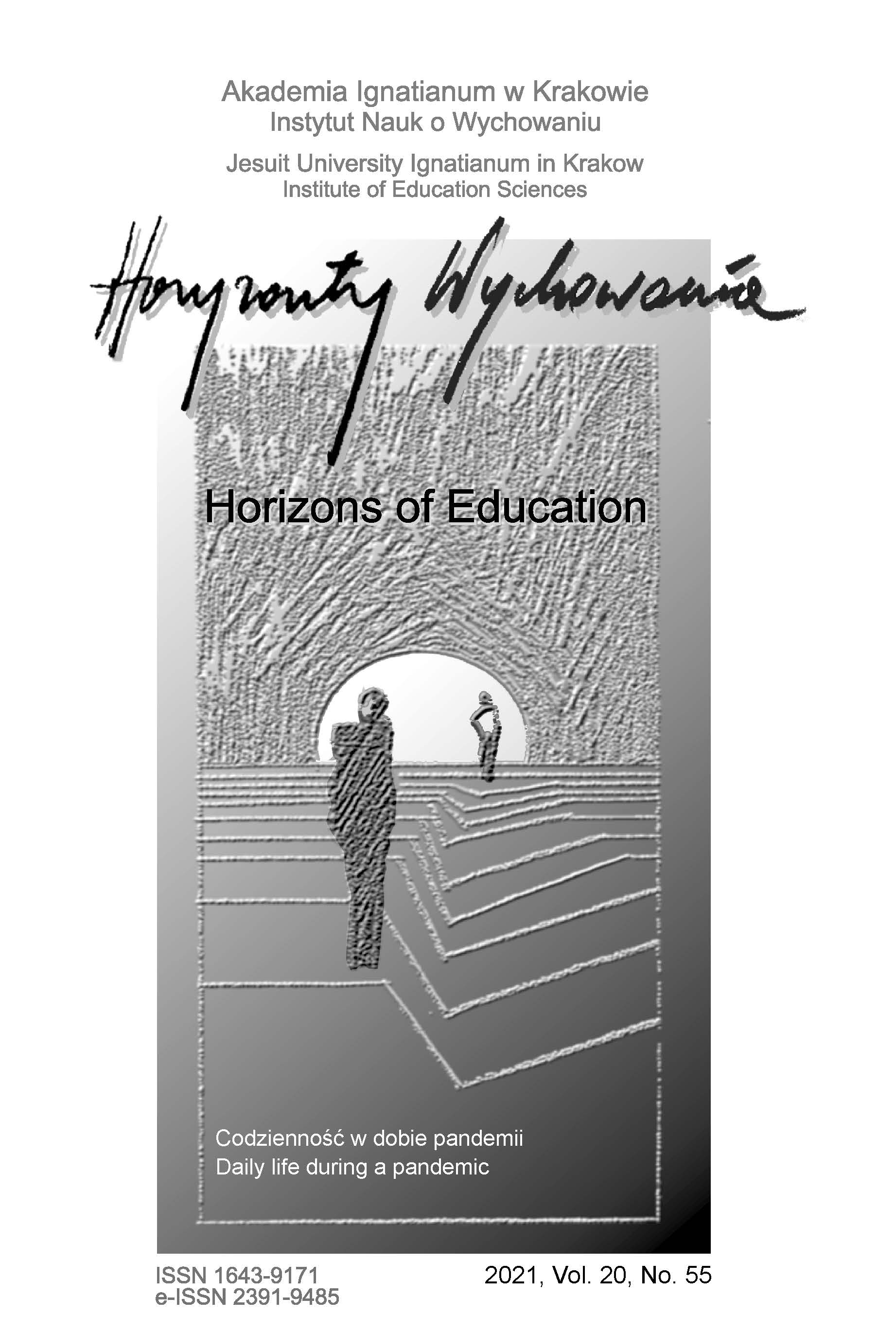Daily Professional Life of Instamums During the Pandemic
Abstract
RESEARCH OBJECTIVE: The scientific aim of this article is to present the daily life of female insta‑women in the context of changes that have been imposed on families by the epidemic situation in Poland.
THE RESEARCH PROBLEM AND METHODS: The research problem discussed in this article is the need to reorganize the everyday life of instamums women during a pandemic.
THE PROCESS OF ARGUMENTATION: The first part reviews the literature on the role of social media in daily life of women, including those who have children, and the transformations in the professional situation of mothers in 2020. The second part of the article presents the results of own research carried out by the method of analysis the content of posts shared by mothers on Instagram during the pandemic.
RESEARCH RESULTS: The result of our own research is a thick description of daily life of mothers during the pandemic from the perspective of women who share their experiences with Instagram.
CONCLUSIONS, INNOVATIONS, AND RECOMMENDATIONS: The current recommendations for practices aimed at shaping the work‑life balance have become inadequate to the pandemic daily life of working mothers
References
Bednarska, M. (2020). Zamiast wprowadzenia. Wychowanie dziecka w otoczeniu mediów. W: N. Bednarska (red.), Dziecko – media – rozwój. O konsekwencjach obecności mediów w życiu dziecka (s. 9‑16). Wydawnictwo Akademii Pedagogiki Specjalnej.
Belanche, D., Flavián, M. i Ibáñez‑Sánchez, S. (2020). Followers’ reactions to influencers’ Instagram posts. Spanish Journal of Marketing‑ESIC, 24(1), 37‑53.
Boerman, S.C. (2020). The effects of the standardized Instagram disclosure for micro‑and meso‑in‑fluencers. Computers in Human Behavior, 103, 199‑207.
Buksa, Ł. i Luber, M. (2020). Matka XXI wieku. Funkcjonowanie instamatki w cyfrowym świecie. W: J. Kawa i M. Stradomska (red.). Kwestie i problemy społeczne współczesnego świata (t. 1, s. 53‑66). Wydawnictwo Naukowe Archaegraph.
CBOS. (2019). Oszacowanie rozpowszechnienia oraz identyfikacja czynników ryzyka i czynników chroniących hazardu i innych uzależnień behawioralnych – edycja 2018/19. Raport z badań. Krajowe Biuro ds. Przeciwdziałania Narkomanii, Ministerstwo Zdrowia, CBOS. https://www.google.com/url?sa=t&rct=j&q=&esrc=s&source=web&cd=&cad=rja&uact=8&ved=2ahUKEwjwgqv6487vAhWD2uAKHQPxDTcQFjAAegQIAxAD&url=https%3A%2F%2Fwww.kbpn.gov.pl%2Fportal%3Fid%3D15%26res_id%3D9249205&usg=AOvVaw1KUwbAoY6pkjOl60_whNnu
Deloitte. (2021). Wpływ pandemii na perspektywy rozwoju zawodowego kobiet w biznesie. Jak pracodawcy mogą wspierać rozwój kobiecych talentów. Raport z badania. https://www2.deloitte. com/pl/pl/pages/kobiety-w biznesie/articles/raport-wplyw-pandemii-na-perspektywy-rozwoju‑-zawodowego-kobiet-w-biznesie.html
Eurofound. (2020). Living, working and COVID‑19. Eurofound https://www.eurofound.europa.eu//report/2020/living-working-and-covid-19
Geertz, C. (2003). Opis gęsty – w stronę interpretatywnej teorii kultury. W: M. Kempny i E. Nowicka (red.), Badanie kultury: element teorii antropologicznej (s. 35‑58). Wydawnictwo Naukowe PWN.
Grotowska, S. (2019). Obraz macierzyństwa w polskiej blogosferze parentingowej. Horyzonty Wychowania, 18(45), 23‑33.
GUS. 2021. Monitoring Rynku Pracy. Kwartalna informacja o rynku pracy w czwartym kwartale 2020 r. https://stat.gov.pl/obszary-tematyczne/rynek-pracy/pracujacy-bezrobotni-bierni-zawodowo-wgbael/monitoring-rynku-pracy-kwartalna-informacja-o-rynku-pracy-w-czwartym-kwar‑tale-2020-r-,12,45.html
IAB Polska. (b.d.). Przewodnik po social media w Polsce. Pobrano 22 lutego 2021 r. z: https://www.iab.org.pl/wp-content/uploads/2020/01/IAB-Przewodnik-po-Social-Media-w-Pol‑sce-2019-2020-1.pdf
Kemp, S. (2020). Digital 2020: October Global STATSHOT. https://datareportal.com/reports/digital-2020-october-global-statshot
Kowalska, M. (2016). Polskie kobiety jako użytkowniczki mediów społecznościowych. Marketing i Rynek, 3(16), 367‑378.
Krasnova, A. i Mizera‑Pęczek, P. (w druku). #mamawracadopracy‑Instagram jako przestrzeń wymiany informacji o dylematach matek związanych z powrotem do pracy po urlopach macierzyńskich
Łosiewicz, M. (2020), Blogi parentingowe jako platforma (auto) prezentacji współczesnej polskiej rodziny. Horyzonty Wychowania, 19(49), 127‑139.
Młyński, J. (2020). Rodzina w sytuacji pandemii koronawirusa COVID‑19 jako wyzwanie dla polityki lokalnej. W: N. Pikuła, M. Grewiński, E. Zdebska i W. Glac, Wyzwania dla polityki społecznej w kontekście pandemii koronawirusa (s. 69‑88). Wydawnictwo Scriptum.
Moujaes, M. i Verrier, D. (2020). Instagram use, instamums, and anxiety in mothers of young children. Journal of Media Psychology: Theories, Methods, and Applications. Advance online publication. https://doi.org/10.1027/1864-1105/a000282
Pluta, M. (2020). #breastcancer – wspierająca rola Instagrama dla kobiet z rakiem piersi. W: P. Siuda i M. Pluta (red.), Internet, zdrowie i choroba. Powiązania społeczne, kulturowe i edukacyjne(„Kultura medialna i komunikacja społeczna”, t. 2, s. 20‑44). Wydawnictwo Uniwersytetu Kazimierza Wielkiego.
Raport (b.d.). Raport Mama‑Warszawianka. Mama na rynku pracy. Wygrajmy z COVID‑em. Fun‑dacja Sukcesu Pisanego Szminką. Pobrano 27 lutego 2021 r. z: https://www.um.warszawa.pl/sites/all/files/download_file.php?file=/sites/default/files/attach/aktualnosci/raport_mama_warszawianka_listopad_2020.pdf
Urbaś, J. (2021). Instamatka ekspertka – rola Instagrama w upowszechnianiu wiedzy o tematyce dziecięcej. Studia Socialia Cracoviensia, 11(1), 75‑89.
Uzależnienia behawioralne. (b.d.). „Młode matki najintensywniej korzystają z Instagrama”. Czy to one są najbardziej zagrożone uzależnieniem? Pobrano 15 lutego 2021 r. z: https://www.uzaleznie‑niabehawioralne.pl/raporty-z-badan/siecioholizm-raporty-z-badan/mlode-matki-najintensywniej‑-korzystaja-z-instagrama-czy-to-one-sa-najbardziej-zagrozone-uzaleznieniem-od-tego-medium/
Wicińska, K. (2017). Media społecznościowe jako narzędzie rozwijające działania marketingowe przedsiębiorstw. Rynek – Społeczeństwo – Kultura, 3(24), 115-121.
Zub, M. (red.). (2020). Analiza społeczno‑gospodarcza wraz z diagnozą obszarów interwencji EFS. Raport końcowy. Ministerstwo Funduszy i Polityki Regionalnej. https://www.power.gov.pl/media/98143/Analiza_spolgosp.pdf
Copyright (c) 2021 HORIZONS OF EDUCATION

This work is licensed under a Creative Commons Attribution-NoDerivatives 4.0 International License.
Authors who publish in this journal agree to the following terms:
- Authors retain the copyright to their work while granting the journal the right of first publication. The work will be simultaneously licensed under a CC BY-ND license, which permits others to share the work with proper credit given to the author and the original publication in this journal.
- Authors may enter into additional, non-exclusive agreements for the distribution of the published version of the work (e.g., posting it in an institutional repository or publishing it in another journal), provided that the original publication in this journal is acknowledged.
We allow and encourage authors to share their work online (e.g., in institutional repositories or on personal websites) both before and during the submission process, as this can foster beneficial exchanges and lead to earlier and increased citations of the published work. (See The Effect of Open Access). We recommend using any of the following academic networking platforms:





